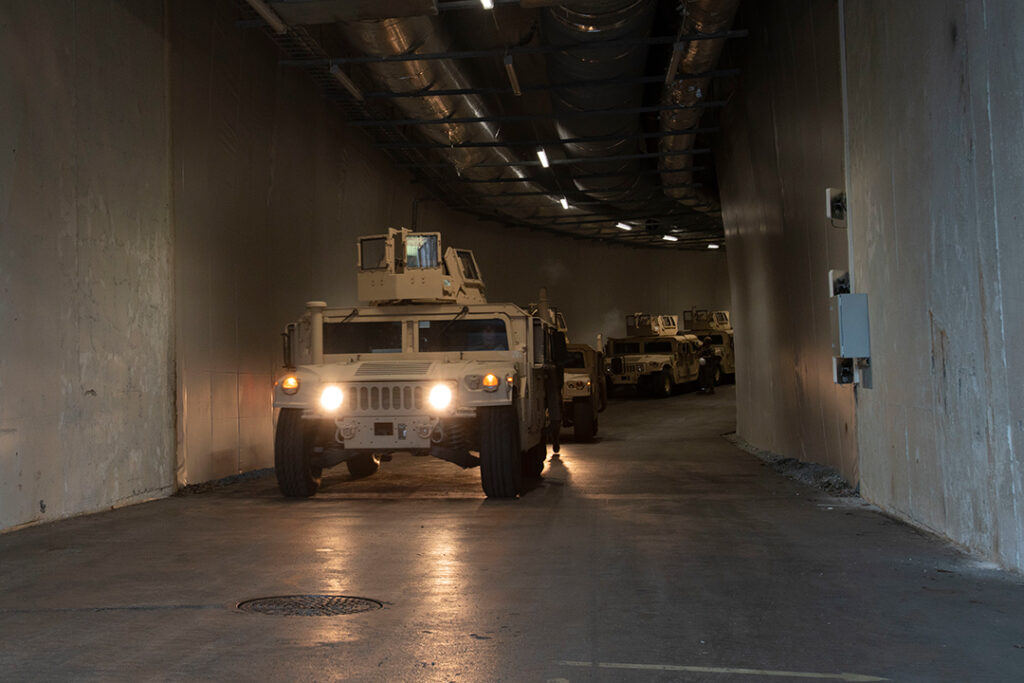THE WATCH STAFF
The U.S. Navy recently announced the installation of a field hospital in a unique setting — a Norwegian cave.
Naval Forces Europe (NAVEUR) and U.S. Navy Expeditionary Medical Support Command (NEMSCOM) set up the facility in the purpose-built caves in the Bogen Bay area of northern Norway, 100 miles north of the Arctic Circle, according to an October 29, 2021, Navy news release and the Insider website.
While the location may seem out of the ordinary, it was the just the latest U.S. military deployment to Norway’s underground system, which includes Marine Corps combat equipment ranging from amphibious vehicles to tanks, according to a 2016 Defense News story. (Pictured: U.S. Marine Corps vehicles exit Norway’s cave system in 2020.)
NAVEUR, in coordination with NEMSCOM, helped deliver the 150-bed mobile Expeditionary Medical Facility (EMF).
Lt. Cmdr. Anthony Skrypek, a NAVEUR force medical planner, worked extensively to return the capability to an Arctic region where Russia’s military activity has concerned Norway and fellow NATO allies.
“I’ve been working this project for three years and it is a great feeling to see it across the finish line,” Skrypek said, according to the Navy news release. “This move shows our commitment to Norway and Europe and will allow us to exercise medical and logistical processes in an Arctic environment, which improves interoperability with NATO allies and partners.”
Senior Norwegian military leaders welcomed the development.
“The move is a clear demonstration that the United States remains committed to the defense of Norway and of Europe,” Lt. Gen. Yngve Odlo, commander of the Norwegian Joint Headquarters, said in the news release.
The EMFs can be sent around the world in a crisis.
“Expeditionary Medical Facilities are deployable on short notice and contain many capabilities of a modern hospital,” said Lt. Cmdr. Michael Lucas, the NEMSCOM director of operations.
The EMFs consist of 20 intensive-care beds, 130 acute-care beds, four operating rooms, an emergency room and a laboratory, as well as the ability to conduct X-rays and CT scans, according to the news release.
“A benefit of the EMF is its self-sufficiency and sustainability due to the variety of civil engineering support equipment present in the caves,” Lucas said. “The caves provided an excellent storage solution for quick stow and EMF deployment.”
The eight caves in the system are large, with wide passageways, high ceilings and smooth concrete floors. They also maintain a constant temperature and humidity, according to Defense News. The caves were all built for the military purpose, not modified from existing formations, and were conceived under a Cold War plan to position equipment for the defense of NATO. The first cave opened in 1982, and the complex was completed in 1988, according to Defense News.
“In this era of great power competition, distributing our capabilities around the globe drives down risk,” Rear Adm. Michael T. Curran, the director of readiness and logistics for U.S. Naval Forces Europe-Africa/U.S. 6th Fleet, said in the news release.
“The movement of an expeditionary hospital to Norway is a perfect example of how U.S. and allied forces provide mutual support in developing a resilient medical and logistics network.”
IMAGE CREDIT: CPL. CLAUDIA NIX/U.S. MARINE CORPS

